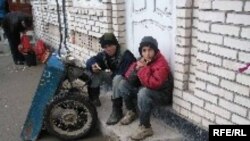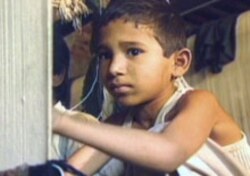Prague, 15 December 2005 (RFE/RL) – The United Nations’ top development goal is to halve the number of people living in poverty in the next 10 years.
But UNICEF, in its latest report, warns that this objective will never be achieved unless immediate attention is focused on the world’s poorest children.
UNICEF calls these children the "excluded and invisible." Paradoxically, some of them are very visible -- they are the beggars on the street, the manual workers in the fields, the prostitutes in the red-light districts. But for the authorities, they often do not officially exist. Their births are often not registered. They do not go to school. They have no medical files.
"They live in the poorest segments of these societies and communities. They're the ones in countries who are among the most impoverished, the ones in countries afflicted by conflict, the ones in countries with weak governance, and the ones in countries where HIV/AIDS is at epidemic levels," David Anthony, the editor of the UNICEF report, said. "At the extremes, these children may disappear from everyone's view. They may not attend school. They do not have access to health-care facilities. They may be locked away in a workplace. They may be harmed and abused. Because the violations of their protection rights are multiplied, they can often become invisible."
A disproportionate number of these "invisible" children are girls, born to mothers who are themselves illiterate. This ensures the cycle of poverty continues, as Cream Wright, UNICEF’s global chief of education, said.
"There are over 800 million illiterate adults in the world, and the great majority of them are women," Wright said. "And for each of these women, they will have children who have far less chance of having a good education, who go on to become mothers in their own right and again have children with fewer chances of gaining an education. So you're perpetuating this cycle of lack of schooling and education, which is intimately linked with poverty."
Gathering statistics about so-called invisible children is a difficult task, as Andrea Rossi, another UNICEF expert, acknowledges. "In most of the cases, people, government, families -- they don't want to speak about it," he said. "Because it's [considered] shameful that in a country your children are working, your children are exploited or your children are forced to go away to another country and maybe work as a domestic worker or a prostitute or in plantations."
UNICEF estimates that 170 million children around the world are forced to work in hazardous environments such as factories, mines, or in agriculture.
The problem is not just limited to the poorest regions of Africa and Asia. Even in comparatively richer regions, like the former Soviet Union, children often suffer the most from poverty. The poorest families often force their underage children to work, limiting their access to education. Sometimes, they become the victims of traffickers and the sex trade.
On average, according to UNICEF, governments in the CIS spend only one-quarter as much on health care as the richest industrialized states. This translates into infant mortality rates that are six times higher than in Western Europe, and maternal mortality rates that are five times higher.
This has a direct effect on demographics, the economy, and future standards of living. In short, according to UNICEF, societies neglect their poor children at their peril.
Cream Wright said there is also a moral aspect. "At the end of the day, when we measure development, it's partly about GNP [gross national product] and about all these other issues," she said. "But it's more about how the weakest in society are treated. And the extent to which a society has developed can be reflected in the extent to which it's fully inclusive."
UNICEF's "The State of the World’s Children" report is available on the Internet at http://www.unicef.org/sowc06/fullreport/full_report.php














